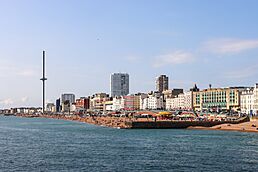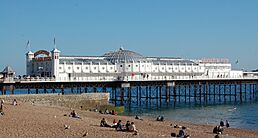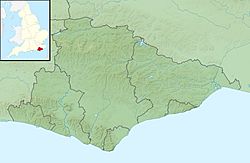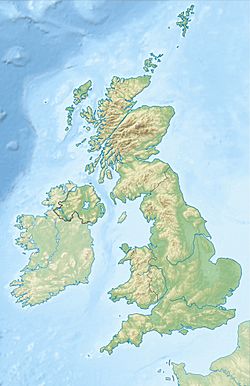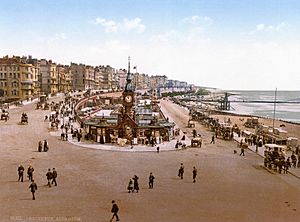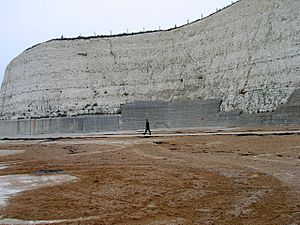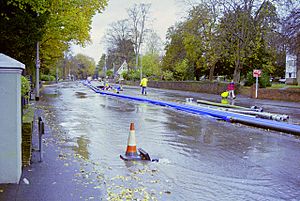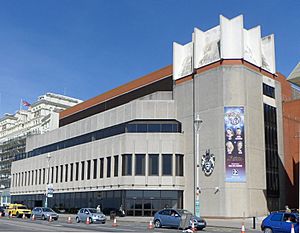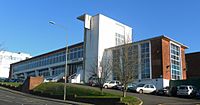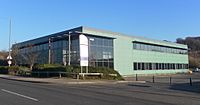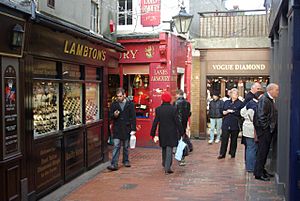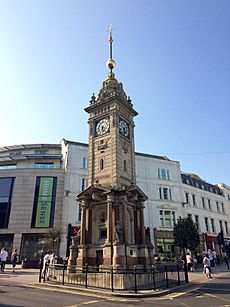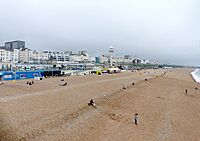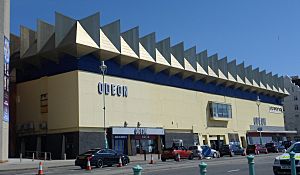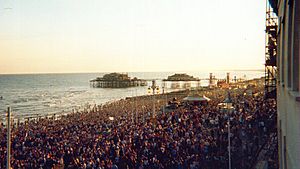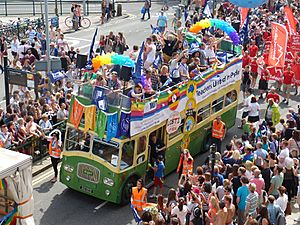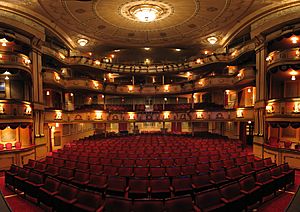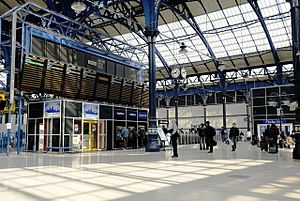Brighton facts for kids
Quick facts for kids
Brighton
|
|
|---|---|
|
Brighton skyline
Brighton Marina
Sea Life Brighton
|
|
| Sovereign state | United Kingdom |
| Constituent country | England |
| Region | South East England |
| Ceremonial county | East Sussex |
| Historic county | Sussex |
| Unitary authority | Brighton and Hove |
| Admin HQ | Hove Town Hall |
| Town charter | 1313 |
| Incorporated | 1854 |
| Unitary authority | 1997 |
| City status | 2000 |
| Government | |
| • Type | Unitary authority |
| Area | |
| • Total | 31.92 sq mi (82.67 km2) |
| Population
(2005 est.)
|
|
| • Total | 290,885 (ranked 45th) (Brighton and Hove pop.) |
| Demonym(s) | Brightonian |
| Time zone | UTC0 (GMT) |
| • Summer (DST) | UTC+1 (BST) |
| Postcode area |
BN
|
| Area code(s) | 01273 |
| ISO 3166-2 | GB-BNH |
| ONS code | 00ML (ONS) E06000043 (GSS) |
| OS grid reference | TQ315065 |
| NUTS 3 | UKJ21 |
| Police | Sussex |
| Fire | East Sussex |
| Ambulance | South East Coast |
| Website | |
Brighton (/ˈbraɪtən/ BRY-tən) is a lively seaside resort city in East Sussex, England. It's part of the wider city of Brighton and Hove. You can find it about 47 miles (76 km) south of London, right by the sea.
People have lived in this area since the Bronze Age, and later during Roman and Anglo-Saxon times. The old name for Brighton was "Brighthelmstone," first written down in the Domesday Book in 1086. The town grew in the Middle Ages but faced tough times with attacks and storms.
In the 1700s, Brighton became popular as a health resort. People believed that swimming in the sea could help them feel better. It became a very fashionable place, especially when Prince Regent (who later became King George IV) started visiting often. He even built the amazing Royal Pavilion here.
When railways arrived in 1841, Brighton became super popular for day trips from London. Many famous buildings like the Grand Hotel and the Palace Pier were built during the Victorian era. Brighton kept growing and joined with the nearby town of Hove in 1997. They became a city in 2000. Today, Brighton and Hove is home to about 290,885 people.
Brighton is known for its friendly atmosphere, cool shops, and exciting arts and music scene. It's often called the UK's "hippest city" and a very happy place to live!
Contents
- Brighton's Name and Nicknames
- A Journey Through Brighton's History
- People and Population
- Brighton's Location and Landscape
- Brighton's Economy and Jobs
- Famous Places and Buildings
- Brighton's Culture and Fun
- Learning and Education
- Sports in Brighton
- Getting Around Brighton
- Famous People from Brighton
- See also
Brighton's Name and Nicknames
The earliest name for Brighton was Bristelmestune, found in the Domesday Book. Over time, it changed to Brighthelmstone. The shorter name "Brighton" started being used around 1660 and became the official name by 1810.
The name comes from old Anglo-Saxon words. Most experts think it means "Beorthelm's homestead" (Beorthelm was a common Old English name). The word tūn means "homestead" or "farm."
Brighton has some fun nicknames too! Poet Horace Smith called it "The Queen of Watering Places," which is still used today. Novelist William Makepeace Thackeray called it "Doctor Brighton," as if the town itself could make you feel better. Many people also call it "London-by-the-Sea" because it's a popular spot for Londoners to visit or even move to.
A Journey Through Brighton's History
The very first people in the Brighton area lived at Whitehawk Camp, a camp from the Neolithic period (around 3500 BC). Archaeologists have found old tools and bones there. Later, Bronze Age and Iron Age settlements also existed, like Hollingbury Castle.
The Romans built villas in the area, and a Roman road passed nearby. After the Romans left, Anglo-Saxons arrived and founded the village of Bristelmestune. It was a fishing and farming village with about 400 people by 1086.
In the 1500s, French invaders attacked and burned the town. But Brighton bounced back, thanks to its busy mackerel-fishing industry. The town grew quickly, and by the 1640s, it was the biggest and most important town in Sussex.
However, Brighton faced more challenges, including storms like the terrible Great Storm of 1703 and a struggling fishing industry. Its population dropped.
Things started to get better in the 1730s. People began to visit Brighton for their health, believing that drinking and bathing in seawater could cure illnesses. A doctor named Richard Russell from nearby Lewes strongly encouraged this. Roads to London also improved, making it easier for visitors to come.
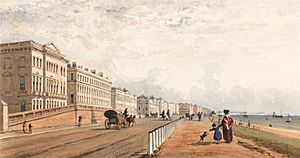
From 1780, Brighton became a very fashionable seaside resort. This was largely thanks to the Prince Regent, who later became King George IV. He loved spending time in Brighton and built the amazing Royal Pavilion here.
The population grew a lot in the 1800s. When the London and Brighton Railway opened in 1841, it made Brighton an easy day trip for people from London. Many famous attractions were built during the Victorian era, like the Grand Hotel, the West Pier, and the Palace Pier.
Brighton continued to expand in the 20th century. In 1997, it joined with the town of Hove to form the unitary authority of Brighton and Hove. In 2000, Queen Elizabeth II officially made Brighton and Hove a city.
People and Population
As of 2017, the Brighton and Hove area, where Brighton is the biggest part, has about 290,885 residents. It's one of the most populated areas in England. Compared to the rest of the country, Brighton has fewer children and older residents. It has a larger number of adults aged 20–44.
Brighton is known for being a welcoming place for everyone. It has a diverse population and is recognized for its open and friendly atmosphere.
Beliefs and Faiths
Brighton is known for having many people who say they don't follow a specific religion. About 42% of the population said they had no religion in the 2011 census. The largest religion in Brighton is Christianity, with 43% of people identifying as Christian. Islam is the second-largest religion, with 2.2% of the population.
Interestingly, in the 2001 census, 2.6% of people in Brighton said their religion was 'Jedi Knight'! This was the highest percentage in the whole country.
Brighton's Location and Landscape
Brighton is nestled between the South Downs hills to the north and the English Channel to the south. The coast here forms a wide, shallow bay. Brighton grew up around a seasonal river called the Wellesbourne. This river used to flow into the English Channel.
The Wellesbourne was covered over in 1793 to prevent flooding. Today, only the street name "Pool Valley" reminds us of the old pond that was once there. Behind Pool Valley is Old Steine, which used to be a marshy area where fishermen dried their nets. Sometimes, after very heavy rain, the Wellesbourne can still appear above ground!
Brighton never became a huge port, but it was sometimes called the "Port of Brighthelmston." The East Cliff, a chalk cliff, runs for several miles from Pool Valley towards Rottingdean. It's about 80 feet (24 meters) high.
Weather in Brighton
Brighton has a mild climate. This means it has cool summers and cool winters, with often cloudy and rainy weather. Heavy snow is rare, but it did snow a lot in 1881 and 1967. Storms have caused damage over the years, including a big one in 1703.
| Climate data for Brighton | |||||||||||||
|---|---|---|---|---|---|---|---|---|---|---|---|---|---|
| Month | Jan | Feb | Mar | Apr | May | Jun | Jul | Aug | Sep | Oct | Nov | Dec | Year |
| Mean daily maximum °C (°F) | 8 (46) |
8 (46) |
9 (49) |
12 (53) |
16 (60) |
19 (66) |
22 (71) |
22 (72) |
18 (65) |
15 (59) |
11 (52) |
9 (48) |
14 (57) |
| Mean daily minimum °C (°F) | 3 (38) |
3 (38) |
4 (40) |
6 (43) |
9 (48) |
12 (53) |
14 (58) |
14 (58) |
12 (54) |
9 (49) |
6 (43) |
4 (40) |
8 (47) |
| Average precipitation mm (inches) | 88 (3.5) |
60 (2.4) |
51 (2.0) |
58 (2.3) |
56 (2.2) |
50 (2.0) |
54 (2.1) |
62 (2.4) |
67 (2.6) |
105 (4.1) |
103 (4.1) |
97 (3.8) |
851 (33.5) |
| Source: Met Office | |||||||||||||
| Jan | Feb | Mar | Apr | May | Jun | Jul | Aug | Sep | Oct | Nov | Dec | Year |
|---|---|---|---|---|---|---|---|---|---|---|---|---|
| 9.2 °C (48.6 °F) | 8.7 °C (47.7 °F) | 8.2 °C (46.8 °F) | 9.6 °C (49.3 °F) | 11.4 °C (52.5 °F) | 13.6 °C (56.5 °F) | 15.4 °C (59.7 °F) | 16.9 °C (62.4 °F) | 17.3 °C (63.1 °F) | 16.3 °C (61.3 °F) | 14.7 °C (58.5 °F) | 12.0 °C (53.6 °F) | 12.8 °C (55.0 °F) |
Brighton's Boundaries
Brighton's size has changed many times over the years. In 1086, it was about 1,640 acres (7 km²). Over time, it grew to include nearby villages like Patcham and Rottingdean. In 1997, Brighton and Hove officially joined together to form one larger area.
The old boundary between Brighton and Hove can still be seen in places. For example, the King Edward Peace Statue stands right on the border. There's also a small alley called Boundary Passage with an old stone marker.
 |
Hove | Gatwick Airport | East Sussex |  |
| Worthing | Eastbourne | |||
| Isle of Wight | English Channel | France |
Brighton's Economy and Jobs
Brighton has been an important place for business and jobs since the 1700s. It's home to some big companies and is a major shopping area for the region. Businesses focused on digital technology and new media are also growing fast.
The tourism industry in Brighton and Hove brings in a lot of money and provides many jobs. The city is also a popular spot for conferences and big events. The Brighton Centre is a special building for these events, bringing in millions of pounds each year.
Businesses and Industries
One of Brighton's largest employers is American Express, which has its European headquarters here. Other big companies include Lloyds Bank and Legal & General. Many people who work at Gatwick Airport also live in Brighton.
The Hollingbury Industrial Estate is a large business area. It used to have many factories, but now it has more shops and commercial businesses.
Brighton is also known as "Silicon Beach" because it has many businesses that work with digital technology and new media. Companies like Brandwatch and Gamer Network are based here.
Shopping in Brighton
Brighton is famous for its many unique and independent shops, which give the city its special feel.
If you walk from Brighton station, you'll find the North Laine area. It's full of cafes, bars, theaters, and over 400 independent and unusual shops. Many streets here are just for walking. The name "Laine" comes from an old Anglo-Saxon word meaning "fields."
Close to the seafront are The Lanes, a maze of narrow alleyways. This area follows the old street plan of the original fishing village. The Lanes are packed with clothing stores, jewelers, antique shops, restaurants, and pubs.
Churchill Square is a large shopping center with over 80 shops, restaurants, and parking spaces. It was rebuilt in 1998 and is now an indoor mall. Other shopping areas include Western Road and London Road.
You can also find weekly flea markets in Brighton, like the one at Brighton Marina and another at Brighton Racecourse.
Famous Places and Buildings
The Royal Pavilion is a stunning former royal palace. It was built for the Prince Regent in the early 1800s. It looks like a palace from India with its unique Indo-Saracenic architecture and amazing Oriental-style rooms inside.
Brighton used to have three piers. The first was the Chain Pier, which was destroyed in a storm in 1896. Today, you can only see small bits of it at low tide.
The Brighton Marine Palace and Pier (usually called the Palace Pier) opened in 1899. It's a fun pleasure pier with a funfair, restaurants, and arcade games. The West Pier was built in 1866 and is a very important historic pier. It has been closed since 1975 and was damaged by fires in 2003.
The Brighton i360 is a tall observation tower that opened in 2016. It's 162 meters (531 feet) high, and a glass pod takes you up to 138 meters (453 feet) for amazing views. It's Britain's tallest observation tower outside London.
The Brighton Clock Tower was built in 1888 to celebrate Queen Victoria's jubilee. It stands at a busy crossroads in the city center.
Volk's Electric Railway runs along the beach from Palace Pier to Brighton Marina. It started in 1883 and is the oldest working electric railway in the world.
The Grand Hotel was built in 1864. Its blue lights at night make it stand out along the seafront.
Churches and Other Places of Worship
St Nicholas Church might be the oldest building in Brighton. It's known as "The Mother Church." Other important churches include the very tall St Bartholomew's and St Peter's. Brighton also has several Roman Catholic churches, Quakers' Meeting House, and a Unitarian community.
The city is home to five synagogues, including the historic Middle Street Synagogue. There are also several mosques and Buddhist centers, showing Brighton's diverse community.
Brighton's Beaches
Brighton has a 5.4-mile (8.7 km) long shingle beach. At low tide, a flat sandy area appears. The seafront is full of restaurants, sports facilities, arcades, and bars. The Palace Pier section of the beach has a special "blue flag status," meaning it's very clean and safe.
The city council owns all the beaches, which are divided by structures called groynes. These were first built in 1724 to protect the coast. To the east of the city center, part of the beach was redeveloped in 2007 with a playground, mini-golf, and beach volleyball courts.
The Madeira Terrace, a long stretch of seafront arches, is being restored. In front of it, a new outdoor swimming center is being built. To the east of Brighton, you'll find one of Europe's largest marinas.
Liz Williams Butterfly Haven
The Liz Williams Butterfly Haven is a special area created to attract and protect butterflies. It's located between Dorothy Stringer and Varndean College. This haven was created in 2006-2007 and has become a home for many different wildflowers and grasses. It's named after Liz Williams, a botanist who helped make the area so rich in plant life. Many butterfly species, like the Adonis blue and chalkhill blue, have been seen here.
The Woodvale Cemeteries
Woodvale is actually five connected cemeteries on the western side of Race Hill. These areas are peaceful places with woods, clearings, and shady paths. They have become a home for much of the local wildlife over the last 150 years. You can find old beech trees, and animals like woodpeckers and Badgers live here. It's a great spot to see nature.
Brighton's Culture and Fun
Food and Drink
Brighton is famous for its many small restaurants and independent coffee shops. It has about 250 restaurants! The city is especially known for having lots of vegan and vegetarian places. In fact, a study in 2022 found that Brighton has the most vegan restaurants per person in the UK.
Media in Brighton
Brighton has its own local TV channel, Latest TV, which shows local news and entertainment. You can also listen to local radio stations like BBC Radio Sussex and Heart South. The main local newspaper is The Argus.
Movies and Cinema
Brighton has been featured in many popular movies, including Quadrophenia (1979) and Brighton Rock (2010).
The Duke of York's Picturehouse opened in 1910 and is the oldest cinema in the country that was built just for movies. It still shows independent films. Brighton also has larger cinemas like the Odeon and Cineworld.
Festivals and Events
Past Events
In 1974, Brighton hosted the Eurovision Song Contest at the Brighton Dome. This was where ABBA won with their famous song "Waterloo"!
Local DJ Fatboy Slim has put on huge "Big Beach Boutique" shows on Brighton beach, attracting hundreds of thousands of people.
Current Festivals
Every May, Brighton hosts the Brighton Festival, which is the second-largest arts festival in the UK. It includes parades, outdoor shows, theater, music, and art. The Brighton Fringe festival also happens at the same time, offering even more performances.
Brighton has several film festivals:
- CINECITY: This festival happens every November and focuses on world cinema.
- Brighton Rocks International Film Festival (BRIFF): This festival in June showcases independent films.
- Brighton International Animation Festival (BIAF): This festival in April focuses on animated films.
- Oska Bright Film Festival: This special festival shows films made by people with learning disabilities or autism.
Brighton Pride is a huge celebration that brings many people to the city every August. It's one of the biggest Pride events in the UK.
The Brighton Comedy Festival takes place every October at the Brighton Dome. It features many comedians and live comedy shows.
The annual Brighton Digital Festival explores technology and culture. Other festivals include The Great Escape (a music festival), Soundwaves Festival (classical music), and Burning the Clocks (a winter celebration).
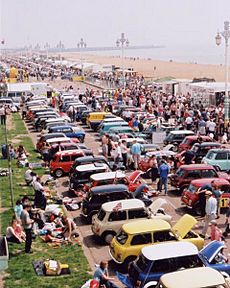
Brighton is also the finish line for famous events like the veteran car run and bike ride from London. You can sometimes see groups of mods and rockers with their scooters and motorbikes here.
Food festivals include the Blessing of the Fisheries, where grilled mackerel is eaten on the beach, and the Fiery Foods Chilli Festival. There's also a general food festival twice a year.
Nightlife and Music
Brighton has a lively nightlife with many clubs and bars. It's also known for its connection to popular musicians like Fatboy Slim and Nick Cave. Live music venues include Concorde 2, the Brighton Centre, and the Brighton Dome. Brighton also hosts The Great Escape Festival, a big music festival every May.
Many successful bands and artists have come from Brighton, including The Kooks, Royal Blood, and Rizzle Kicks.
Theatre
Brighton has several theaters. The Brighton Dome and its Pavilion Theatre host many shows. Komedia is known for comedy and music, but also has theater. The Theatre Royal is a historic theater that celebrated its 200th anniversary in 2007. There's also the Brighton Open Air Theatre, which opened in 2015.
Parks and Green Spaces
Stanmer Park is a large park on the northern edge of Brighton, extending into the South Downs. The biggest park in the city is Preston Park. The Level was recently updated and is a popular spot. Other parks include East Brighton Park and Queen's Park.
Learning and Education
Brighton is home to two universities. The University of Brighton has been here since 1859 and has about 18,000 students. It has campuses across the city.
The University of Sussex was founded in 1961 and is located outside the city center, near Stanmer Park. It has about 20,000 students and is known for its research.
In 2001, the BIMM music college (British and Irish Modern Music Institute) opened in Brighton. It's now Europe's largest music college. Famous alumni include James Bay and Tom Odell.
The universities of Brighton and Sussex also have a medical school together, called Brighton and Sussex Medical School.
Brighton & Hove City Council manages 80 schools, with 54 of them in Brighton. For students over 16, there's Greater Brighton Metropolitan College for vocational subjects and Brighton Hove & Sussex Sixth Form College (BHASVIC) for academic subjects. Varndean College is another college offering various courses.
There are many state schools and some private schools in Brighton. Some well-known secondary schools include Longhill High School and Dorothy Stringer School. Brighton is often ranked as a top student city in the UK.
Sports in Brighton
Football
Brighton & Hove Albion Football Club is the city's professional football team. They play at Falmer Stadium, also known as 'the Amex'. The team was promoted to the Premier League in 2017, which was a big achievement! They also reached the 1983 FA Cup Final.
Whitehawk Football Club is another local football team that plays in east Brighton.
Rugby
Brighton Football Club (RFU) is one of England's oldest rugby clubs, started in 1868.
Brighton was one of the host cities for the 2015 Rugby World Cup. Two games were played at Falmer Stadium, including a famous match where Japan beat South Africa!
Hockey
Brighton & Hove Hockey Club is a large hockey club that plays its matches at Blatchington Mill School.
Cricket
Sussex County Cricket Club plays at the County Cricket Ground in Hove. This ground has hosted international cricket matches for both men and women.
Other Sports
Motoring events, like the Brighton Speed Trials, happen on Madeira Drive along Brighton's seafront. This race has been running since 1905.
Brighton has a horse racing course, Brighton Racecourse. There's also a greyhound racing track in Hove.
Brighton Sailing Club has been active since the 1870s. The Brighton and Hove Pétanque Club also holds competitions.
Brighton has two competitive swimming clubs, and many people enjoy swimming in the sea. Amateur track cycling takes place at the Preston Park Velodrome, which is the oldest velodrome in the UK, built in 1877. You can also find surfing spots near Brighton.
Getting Around Brighton
Brighton has many ways to get around, including trains, buses, coaches, and taxis.
Roads
The A23 connects Brighton to London. Two other main roads, the A259 and the A27, run east and west. The A27 now goes around the city on the Brighton Bypass, which opened in 1992.
There are many parking spaces in central Brighton, including a large underground car park at Regency Square.
Railway
Trains run frequently from Brighton railway station. Many people who live in Brighton travel to London for work. Trains also go to Gatwick Airport and other towns along the coast like Portsmouth and Eastbourne. The fastest train to London Victoria takes about 51 minutes.
Buses
The Brighton & Hove Bus Company runs most of the bus services in the city. They have a large fleet of buses. Other companies like Compass Travel and The Big Lemon also operate services. Many bus stops have screens that show when the next bus will arrive.
Brighton has a park and ride facility at Withdean Stadium. This means you can park your car there and take a bus into the city center.
Air Travel
Shoreham Airport, a small airport for light aircraft, is about 9 miles (14 km) west of Brighton. Gatwick Airport, a major international airport, is about 30 miles (48 km) north of Brighton. You can easily get to Gatwick by train or coach from Brighton.
Famous People from Brighton
- Lily Agg, footballer
- ArrDee, rapper
- Michael Ashburner, geneticist
- Bald and Bankrupt, travel vlogger
- Zoe Ball, entertainer
- Brian Behan, writer and trade unionist
- Nick Berry, actor and singer
- Cate Blanchett, actress
- Laurence Rickard, actor and screenwriter
- Raymond Briggs, illustrator
- Dora Bryan, actress
- George Burchett, tattoo artist
- Nick Cave, musician
- Gwendoline Christie, actress
- Steve Coogan, actor and comedian
- Norman Cook / Fatboy Slim, DJ
- Richard P. Cook, artist
- Robin Cousins, ice skater
- Luke Cresswell, percussionist
- Alfie Deyes, YouTuber
- Charles Dickens, author
- Maude Dickinson, inventor
- Lewis Dunk, footballer
- E. S. Elliott, writer
- Chris Eubank, boxer
- Anubis Finch, drag queen
- David Gilmour, musician
- Dave Greenfield, musician
- Cyriak Harris, animator, artist, composer, and author
- Elliott Hasler, director
- Ben Hawes, triple Olympian
- David Henty, former master forger
- Jacksepticeye, YouTuber
- Peter James, author
- Mike Kerr, musician
- Rudyard Kipling, author
- Marzia Kjellberg, internet personality
- Joan Lazzarani, sculptor, musician and intermedia performance artist
- Joshua Le Gallienne, artist, predominantly in sculpture
- Charles Leggett, music cornetist
- Emma Lomax, composer and pianist
- Garnt Maneetapho, YouTuber, known online as "Gigguk"
- Jack Manifold, YouTuber and streamer
- James Marriott, musician and YouTuber
- Heather Mills, model
- Isaiah Aram Minasian, violinist, cellist and orchestrator
- John Nathan-Turner, producer
- David Pearce, transhumanist philosopher
- PewDiePie, YouTuber
- The Prince Regent / George IV, royal
- Philip Proudfoot, anthropologist and politician
- Ren, musician
- Clara Ross, composer
- Victor Spinetti, actor
- Ben Thatcher, musician
- Frank Thewlis, Methodist minister
- TommyInnit, YouTuber and streamer
- Tubbo, YouTuber and streamer
- Doreen Valiente, Wiccan writer
- Johnny Wakelin, musician
- David Walliams, comedian, actor and writer
- Joe Wilkinson, comedian
- Zoella, YouTuber
See also
 In Spanish: Brighton para niños
In Spanish: Brighton para niños


